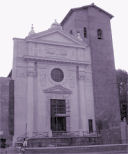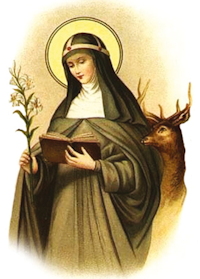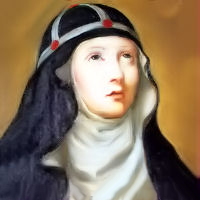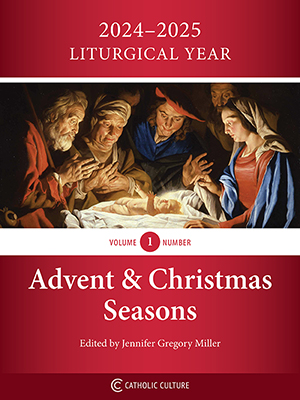Lent: March 24th
Saturday of the Fourth Week of Lent
Other Commemorations: St. Catherine of Sweden, Virgin (RM)
» Enjoy our Liturgical Seasons series of e-books!
"We have been ransomed with the precious blood of Christ, as with the blood of a lamb without blemish of spot" (1 Pt 1:19). Mortification and self-denial are indispensable means of acquiring strength of will and virtuous habits, and of preserving the life of the soul.

Today's Station is at St. Nicholas in Prison. It was constructed in the ruins of two temples and the ancient Forum Olitorium, and you can see fragments from them reused in the church. The most important of the temples was the Temple of Piety, built by Acilius Glabrius, consul in 191 B.C. The dedication to St. Nicholas was made by the Greek population in the area.
Meditation- Mary's Acceptance of All, for Love of Us
Mary, there present as eyewitness to the sacred Passion of her divine Son on Good Friday, was destined to be present in spirit and maternal interest at future scenes in the unending tragedy of Christ Jesus' Passion in His members through all the Christian centuries. She was destined to be present precisely in that high office to which Jesus Himself would assign her at the foot of His cross on Calvary, as the Mother of all who live the divine life of the children of the Second Adam. Hence, to fit her for this office of Mediatrix who would have Christ-like compassion on all our human infirmities, she too must be tempted in all things as we are (without sin), that we might with confidence go to the throne of her mercy, there to obtain the precious grace of Christ-like obedience through her who herself learned perfect obedience by the things which she suffered with her divine Son. She also must be tested that, by her union with the very humiliation and suffering with which the Son purchased His title of High Priest, the Mother too might at the same time purchase her title — Mediatrix of all the graces to be dispensed from the treasury of the Sacred Heart of Him, who alone is in His own right the great High Priest, the universal and plenipotentiary Mediator of the New Testament.
Mark well, therefore—it was on Good Friday, during these hours of darkness and shame and anguish which Mary shared with Jesus most intimately, that the Savior fountains of the Second Adam poured their tenderest mercifulness into the heart of the Second Eve so copiously, that until the Book of Life is filled the whole world might with unlimited filial confidence have recourse to Mary—
The Health of the sick,— Our Way to the Father by Rev. Leo M. Krenz, S.J.
The safe Refuge of sinners,
The sympathetic Comforter of the afflicted,
The unfailing Help of Christians
Things to Do:
St. Catherine of Sweden
Catherine of Sweden, Saint, the fourth child of Saint Bridget of Sweden (q.v.) and her husband, Ulf Gudmarsson, b. 1331 or 1332; d. March 24, 1381. At the time of her death St. Catherine was head of the convent of Wadstena, founded by her mother; hence the name, Catherine Vastanensis, by which she is occasionally called. At the age of seven she was sent to the abbess of the convent of Riseberg to be educated and soon showed, like her mother, a desire for a life of self-mortification and devotion to spiritual things. At the command of her father, when about thirteen or fourteen years old, she married a noble of German descent, Eggart von Kürnen. She at once persuaded her husband, who was a very religious man, to join her in a vow of chastity. Both lived in a state of virginity and devoted themselves to the exercise of Christian perfection and active charity. In spite of her deep love for her husband, Catherine accompanied her mother to Rome, where St. Bridget went in 1349.
 Soon after her arrival in that city Catherine received news of the death of her husband in Sweden. She now lived constantly with her mother, took an active part in St. Bridget's fruitful labors, and zealously imitated her mother's ascetic life. Although the distinguished and beautiful young widow was surrounded by suitors, she steadily refused all offers of marriage. In 1372 St. Catherine and her brother, Birger, accompanied their mother on a pilgrimage to the Holy Land; after their return to Rome St. Catherine was with her mother in the latter's last illness and death.
Soon after her arrival in that city Catherine received news of the death of her husband in Sweden. She now lived constantly with her mother, took an active part in St. Bridget's fruitful labors, and zealously imitated her mother's ascetic life. Although the distinguished and beautiful young widow was surrounded by suitors, she steadily refused all offers of marriage. In 1372 St. Catherine and her brother, Birger, accompanied their mother on a pilgrimage to the Holy Land; after their return to Rome St. Catherine was with her mother in the latter's last illness and death.
In 1374, in obedience to St. Bridget's wish, Catherine brought back her mother's body to Sweden for burial at Wadstena, of which foundation she now became the head. It was the mother-house of the Brigittine Order, also called the Order of St. Savior. Catherine managed the convent with great skill and made the life there one in harmony with the principles laid down by its founder. The following year she went again to Rome in order to promote the canonization of St. Bridget, and to obtain a new papal confirmation of the order. She secured another confirmation both from Gregory XI (1377) and from Urban VI (1379), but was unable to gain at the time the canonization of her mother, as the confusion caused by the Schism delayed the process. When this sorrowful division appeared she showed herself, like St. Catherine of Siena, a steadfast adherent of the party of the Roman Pope, Urban VI, in whose favor she testified before a judicial commission. Catherine stayed five years in Italy and then returned home, bearing a special letter of commendation from the pope. Not long after her arrival in Sweden she was taken ill and died. In 1484 Innocent VIII gave permission for her veneration as a saint and her feast was assigned to March 22 in the Roman Martyrology. Catherine wrote a devotional work entitled "Consolation of the Soul" (Sielinna Troest), largely composed of citations from the Scriptures and from early religious books; no copy is known to exist. Generally she is represented with a hind at her side, which is said to have come to her aid when unchaste youths sought to ensnare her.
—Excerpted from The Catholic Encyclopedia, J.P. Kirsch
Patronage: Vadstena, Sweden; against abortion; for healing and protection from miscarriage
Symbols and Representations: Brigittine abbess with a hind at her side; Brigittine holding a lily; Brigittine dressing a poor man’s wounds; Brigittine being brought Communion on her death bed.
Highlights and Things to Do:
- Read more about St. Catherine of Sweden:
- Visit the Brigidine Sisters website and read about St. Catherine.






